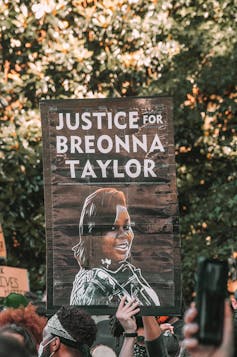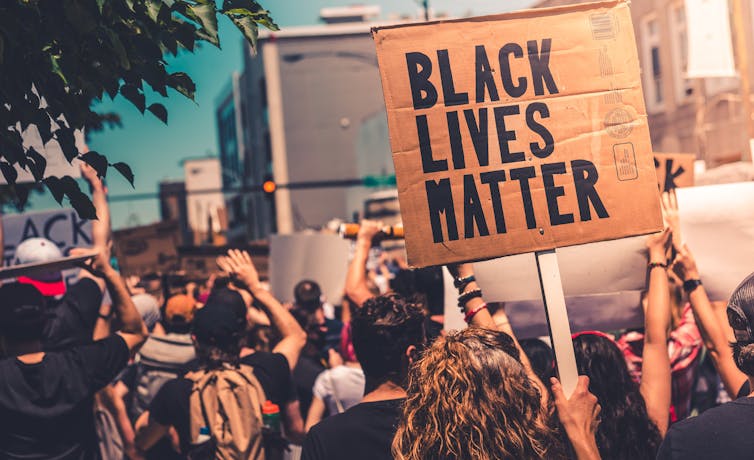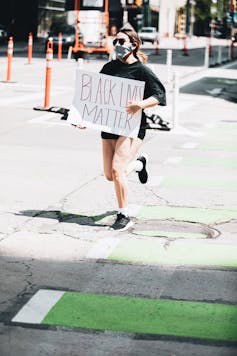The brutal killing of George Floyd by Minneapolis Police Department officer Derek Chauvin captured the public consciousness unlike few other events in American history. In the U.S. and around the world, protesters have taken to the streets outraged by the abhorrent murder of yet another defenceless Black man by police.
The question, however, is how this particular incident has galvanized so many people worldwide — overwhelmingly young — to protest for so long?
Certainly, police brutality directed toward Black people in the U.S. is not new. The chant and hashtag “say their names” brings attention to the brutal killings of Breonna Taylor, Ahmaud Arbery, Eric Garner, Trayvon Martin, Michael Brown and many others, along with George Floyd.
Similarly, here in Canada, Black and Indigenous people have experienced significant brutality at the hands of the police. In recent weeks, the public has seen news of the deaths of Regis Korchinski-Paquet and Chantel Moore, and the arrest of Athabasca Chipewyan First Nation Chief Allan Adam.
Economic and political disadvantages experienced in the U.S. and Canada are not new. Economic disparities between Black and white families in the U.S. have been obvious for years.
 A protester in Atlanta holds a sign with a picture of Breonna Taylor, a Black woman who was shot by police in her home earlier this year. (Unsplash/Maria Oswalt)
A protester in Atlanta holds a sign with a picture of Breonna Taylor, a Black woman who was shot by police in her home earlier this year. (Unsplash/Maria Oswalt)
As in many previous cases, the killing of George Floyd was caught on camera. The recording was striking, producing a visceral impression of a public lynching, but it was not unlike the recordings of Rodney King, Alton Sterling and others in sparking public outcry.
The difference this time around is the contemporaneous outbreak of the COVID-19 pandemic, which has contributed to making these protests more enduring and widespread. COVID-19 has exacerbated the problems of racial injustice, isolation, frustration and stagnation and caused higher unemployment, which provides the time to air these grievances. When coupled with mixed messages from elites, the spark lit a fire that continues to burn.
Mixed messages
Right from the beginning, government officials gave contradictory messages. President Donald Trump told the public on Jan. 22 that the virus was “totally under control” and that he was “not at all” worried about it. A month later, on Feb. 26, he repeated this. By March 15, Trump changed his tune, admitting that the virus was indeed “contagious” and “not under control.” Still, he concluded on March 25 that all would be back to work as usual in “several weeks.” In contrast, governors across the country were declaring states of emergency.
The flip flop regarding the pandemic resulted in mixed messages and demonstrated a division among the elites. When political leaders are divided or provide mixed messages, the public has a variety of authorities to choose from and may ignore whatever semblance of rules are in place. From this, a state of anomie or normlessness can emerge.
Increase in unemployment
COVID-19 policies and government directives have resulted in economic downturn. By May, 20.5 million Americans were unemployed, an increase of 14 million from February. Although the unemployment rate increased for all groups, it was highest among Black Americans and other racialized groups. Unemployment rates for Black men and women in May were 15.8 per cent and 17.2 per cent, respectively, while the national rate of unemployment for all groups was 13 per cent. The rate was even higher among people aged 16 to 24, standing at 25.3 per cent in May.
Unemployed Black people in Canada and the U.S. also faced greater financial challenges to supporting their families due to the pandemic than their white counterparts.
COVID-19 has amplified the ordinary inequality in unemployment, which increases dissatisfaction and inclination towards speaking out.
Frustration and anxiety
By the end of June, more than 10 million people had contracted COVID-19 worldwide and over 500,000 had died. The uncertainty, unemployment and confused government directives on business lockdowns and social distancing increased stress and anxiety.
For some, social distancing felt like house arrest. Frustrations were enhanced by uncertainty due to misinformation. The extent of misinformation was such that some started to believe conspiracies. In addition, the frustration of Black Americans was further increased because they are disproportionately affected by COVID-19 and receive poor health care and treatment.
 Protesters marching in Chicago. (Unsplash/Max Bender)
Protesters marching in Chicago. (Unsplash/Max Bender)
Government advice to shelter at home further increased frustrations and exposed economic inequalities. Black Americans, who are on average significantly less well off than their white counterparts, are more likely to live in crowded housing, work in essential services, have prior health conditions that increase mortality rates and rely on public transport. COVID-19 increased levels of frustration among the public in general, but Black Americans and other minorities have been hit hardest.
In such circumstances, people tend to live in a state of endless suspense, fearful about their health, uncertain of the truth, unable to know when it will end. These can all be drivers toward tangible action to affect change.
Anonymity and extra time
COVID-19 also has a curious effect in enabling protests. Even as health concerns over protests rose, many protesters attended with face masks, providing additional protection from the recognition and prosecution. The existence of CCTV cameras is a deterrence against protests, but masks offer some anonymity that may prevent legal consequences or illegal retribution. The pandemic helped increase participation of those who wished to be involved, but feared surveillance apparatuses.
 A woman wears a face mask during a protest. (Unsplash/Logan Weaver)
A woman wears a face mask during a protest. (Unsplash/Logan Weaver)
But perhaps the greatest factor that allows participation of those with grievances is time. When people have discretionary time, they are more likely to participate in social movements to effect change. Prior to COVID-19, the cycle of work and life limited extra time for taking to the streets to demonstrate for a cause, particularly when a choice had to be made between protesting for a better tomorrow and earning a paycheck.
COVID-19 removed the need to make that decision. All countries experienced increased unemployment, some form of social distancing and lockdown. The consequent extra time provided opportunities for people to join the demonstrations en masse, ensuring that the spark which ignited the protest could last for a long time and grow worldwide.
Intensifying inequalities elevated dissatisfaction while grievances in the U.S. and elsewhere and the video of George Floyd’s death, reminiscent of a public lynching, provided the spark. However, what may have helped make the movement larger, enduring and international in scope were the lockdowns and the mass unemployment that came with them. And although the media has begun to pay less attention, the protesters continue to have the time and motivation to keep the flame burning.


